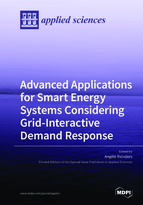Advanced Applications for Smart Energy Systems Considering Grid-Interactive Demand Response
A special issue of Applied Sciences (ISSN 2076-3417). This special issue belongs to the section "Energy Science and Technology".
Deadline for manuscript submissions: closed (30 April 2019) | Viewed by 35182
Special Issue Editor
2. Eindhoven University of Technology (TU/e), Eindhoven, The Netherlands
Interests: sustainable energy systems; product design; photovoltaics; smart energy products; smart grids; PV modules; PV performance; electricity; innovation; and sustainable development
Special Issues, Collections and Topics in MDPI journals
Special Issue Information
Dear Colleagues,
For this Special Issue of the journal Applied Sciences, authors are invited to submit manuscripts covering applied research on smart energy systems, smart grids, smart energy homes, smart energy products and services, and the advanced applications thereof, in the context of demand response and grid interactions. The aim of this Special Issue is to encourage scientists to publish their experimental and theoretical results in as much detail as possible, such that they can be reproduced. There is no restriction on the length of the papers. In particular manuscripts reporting about interdisciplinary research results which combine technical, social, environmental and economic aspects of smart energy systems are appreciated. Moreover, results based on the evaluation of real life cases, energy pilots, prototypes of smart energy products and end user surveys and interviews are welcomed. If possible, a validation of simulated results should be included in a manuscript.
Prof. Dr. Angele Reinders
Guest Editor
Manuscript Submission Information
Manuscripts should be submitted online at www.mdpi.com by registering and logging in to this website. Once you are registered, click here to go to the submission form. Manuscripts can be submitted until the deadline. All submissions that pass pre-check are peer-reviewed. Accepted papers will be published continuously in the journal (as soon as accepted) and will be listed together on the special issue website. Research articles, review articles as well as short communications are invited. For planned papers, a title and short abstract (about 100 words) can be sent to the Editorial Office for announcement on this website.
Submitted manuscripts should not have been published previously, nor be under consideration for publication elsewhere (except conference proceedings papers). All manuscripts are thoroughly refereed through a single-blind peer-review process. A guide for authors and other relevant information for submission of manuscripts is available on the Instructions for Authors page. Applied Sciences is an international peer-reviewed open access semimonthly journal published by MDPI.
Please visit the Instructions for Authors page before submitting a manuscript. The Article Processing Charge (APC) for publication in this open access journal is 2400 CHF (Swiss Francs). Submitted papers should be well formatted and use good English. Authors may use MDPI's English editing service prior to publication or during author revisions.






